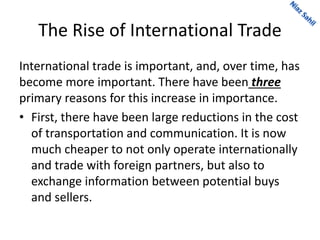International trade involves the exchange of goods and services across borders, driven by factors such as production costs and consumer preferences. It has grown due to lower transportation costs, technological advancements, and reducing trade barriers, offering advantages like resource utilization and consumer variety, while also presenting risks like over-dependence and competition-induced conflicts. Entry modes into international markets include exporting, licensing, franchising, joint ventures, foreign direct investment, and mergers, each with their own benefits and challenges.























































































